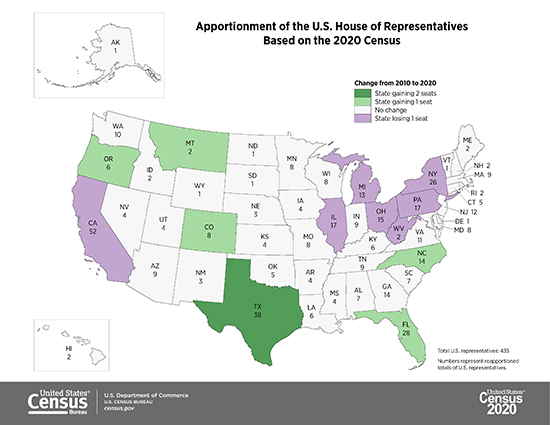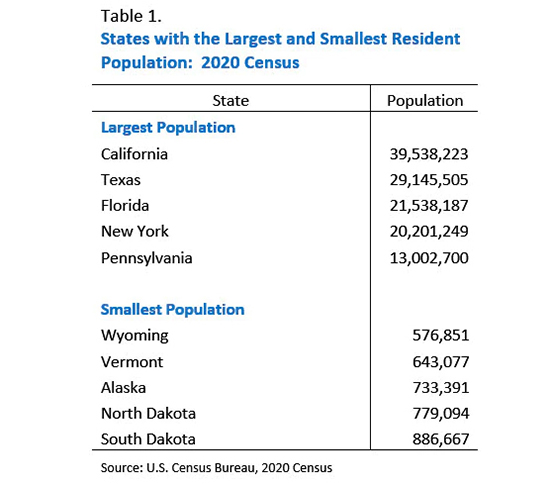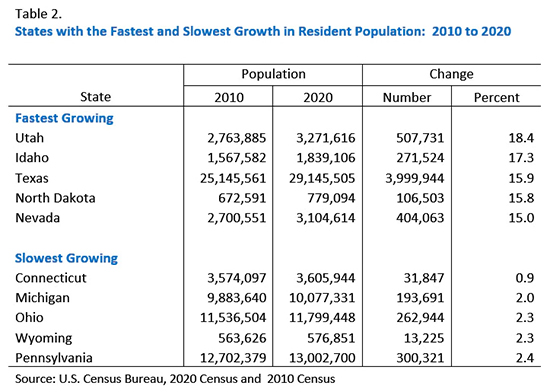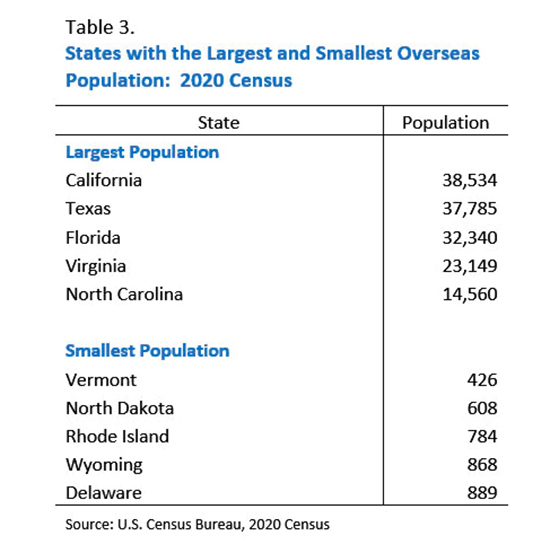U.S. Census Bureau Today
Delivers State Population Totals for Congressional Apportionment
BRYNN EPSTEIN AND DAPHNE LOFQUISTAPRIL 26, 2021:The U.S. Census
Bureau today released the first population counts from the 2020
Census.
At the same time, Secretary of Commerce Gina Raimondo delivered to
the President population counts used for apportionment, along with
the number of seats in the U.S. House of Representatives that will
be allocated to each state based on the 2020 Census.
The population counts used for apportionment include the total
resident population for each of the 50 states, plus a count of U.S.
military and federal civilian employees living overseas (and their
dependents living with them) who could be allocated to a home state.
The 2020 Census shows that the resident population of the United
States, including the 50 states and the District of Columbia, was
331,449,281 as of April 1, 2020, an increase of 7.4% since the 2010
Census.
Apportionment calculations based on the 2020 Census show that
Texas, Colorado, Florida, Montana, North Carolina, and Oregon will
gain seats, while California, Illinois, Michigan, New York, Ohio,
Pennsylvania, and West Virginia will lose seats.
What is Apportionment?
Apportionment is the process of distributing the 435 seats in the
U.S. House of Representatives among the 50 states. Article 1,
Section 2 of the U.S. Constitution requires that apportionment
happen every 10 years based on population counts from the decennial
census.
The District of Columbia and Puerto Rico are not included in the
apportionment process because they do not have voting seats in
Congress, but population counts for those areas were also released
today.
The populations of the U.S. Island Areas — American Samoa, Guam,
the Commonwealth of the Northern Mariana Islands, and the U.S.
Virgin Islands—will not be included in this release, but resident
population counts for those areas will be released later.
For more details on who was counted (and where they were counted),
see the Residence Criteria and Residence Situations for the 2020
Census.
An Apportionment Fact Sheet is available that provides easily
accessible and sharable information about apportionment in a
one-page document.
Calculating Apportionment
The population counts used for apportionment include the total
resident population for each of the 50 states, plus a count of U.S.
military and federal civilian employees living overseas (and their
dependents living with them) who could be allocated to a home state.
For more information about who is included in the apportionment
population counts, visit our Frequently Asked Questions (FAQs).
When calculating apportionment, each of the 50 states gets one seat
in the U.S. House of Representatives. The rest of the seats are
distributed based on each state’s apportionment population.
Following the 1940 Census, Congress adopted the Method of Equal
Proportions for calculating how the rest of the seats are
distributed. It has been used every decade since.
The method first calculates values based on each state’s total
population and the number of potential seats each state could
receive. It then ranks those values to determine how many additional
seats each state gets.
A recently published blog describes the calculation process in more
detail.
The video below describes the purpose and importance of
apportionment. It also explains the apportionment process and how
it’s calculated to ensure equal representation for all.

2020 Census Apportionment Results
The 2020 Census apportionment population for the 50 states is
331,108,434. The apportionment population is the sum of the resident
population for the 50 states (330,759,736) and the overseas
population for the 50 states (348,698).
Apportionment Population
= Resident Population + Overseas Population
331,108,434 = 330,759,736+ 348,698
Based on the 2020 Census apportionment population counts, 7 House
seats will shift among 13 states. One state will gain two seats
(Texas), and 5 states will gain one seat (Colorado, Florida,
Montana, North Carolina, and Oregon). Seven states will lose one
seat (California, Illinois, Michigan, New York, Ohio, Pennsylvania,
and West Virginia).
California, Texas, Florida, and New York are the four states
that will have the largest number of representatives, and Alaska,
Delaware, North Dakota, South Dakota, Vermont, and Wyoming are the
states that will have only one representative each.
The average congressional district population size will increase.
Each member of the House of Representatives will represent an
average of 761,169 people based on the 2020 Census. This will be an
increase of 50,402 (7.1% increase) compared with the average of
710,767 people per representative based on the 2010 Census.
Delaware will have the largest average district size (990,837),
while Montana will have the smallest average district size
(542,704).
2020 Census Resident Population
The 2020 Census resident population of 331,449,281 includes all
people living in the 50 states and the District of Columbia as of
April 1, 2020.
Of the U.S. resident population, 37.2% (123,425,864) lived in the
five most populous states in 2020 and over a quarter (27.2%) were in
the three largest states: California, Texas, and Florida (Table 1).

Table 1. States with the Largest and Smallest Resident
Population: 2020 Census
The five least-populous states had a combined resident population
of 3,619,080. Those five states – Wyoming, Vermont, Alaska, North
Dakota, and South Dakota – made up 1.0% of the U.S. resident
population.

Table 2. States with the Fastest and Slowest Growth in Resident
Population: 2010 to 2020
Utah was the fastest-growing state, followed by Idaho, Texas, North
Dakota, Nevada (Table 2). The five states with the slowest
population growth, all under 2.5%, were: Connecticut, Michigan,
Ohio, Wyoming, and Pennsylvania. North Dakota, with one of the
smallest resident populations (779,094), had one of the largest
percent increases in population size (15.8%). Illinois, Mississippi,
and West Virginia were the states that lost population.
2020 Census Overseas Population
The 2020 Census overseas population for the United States,
including the 50 states and the District of Columbia, was 350,686.
This included military or civilian employees of the U.S. government
who were stationed or assigned outside the United States on April 1,
2020, as well as their dependents living with them outside the
United States.
U.S. government agencies and departments provided the Census Bureau
with counts of their employees and their dependents living overseas
by the employees’ home state listed in agency administrative
records.

Table 3. States with the Largest and Smallest Overseas
Population: 2020 Census
The five states with the largest overseas populations had a
combined 41.7% (146,368) of the total overseas population. Three of
the states with the largest overseas population were also the states
with the largest resident population: California, Texas, and Florida
(Table 3).
The five states with the smallest overseas population had a
combined overseas population of 3,575, or 1.0% of the total overseas
population. Three of the states with the smallest overseas
population, Vermont, North Dakota, and Wyoming, were also some of
the states with the smallest resident population.
More 2020 Census Apportionment Data
The 2020 Census apportionment data tables were published on the
apportionment press kit webpage today, along with many other
resources for information about apportionment.
A few days after the apportionment release, a set of supplemental
tables will be published on a new 2020 Census Apportionment Results
webpage that will be linked to the apportionment press kit webpage.
These tables will include additional data on the apportionment
population and its components, as well as historical changes in the
number of seats each state has in the U.S. House of Representatives.
2020 Census data will also be added to the Historical Apportionment
Data Map within a week after the apportionment release.
Brynn Epstein is a statistician and an apportionment project
analyst at the Census Bureau.
Daphne Lofquist is a statistician and an apportionment project
analyst at the Census Bureau. |